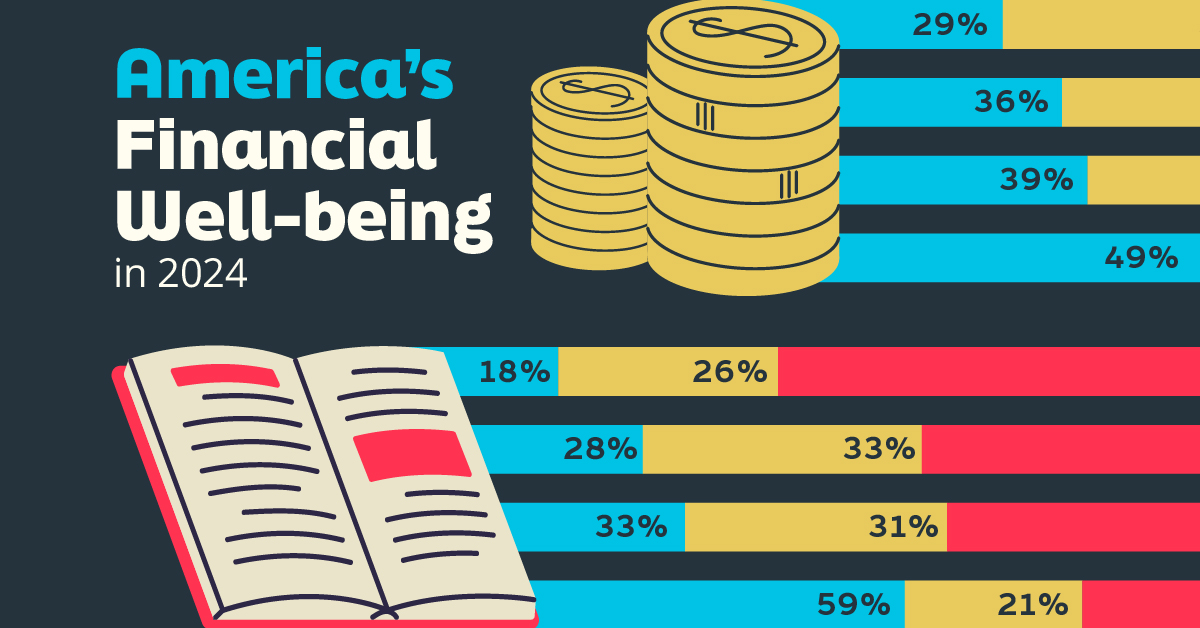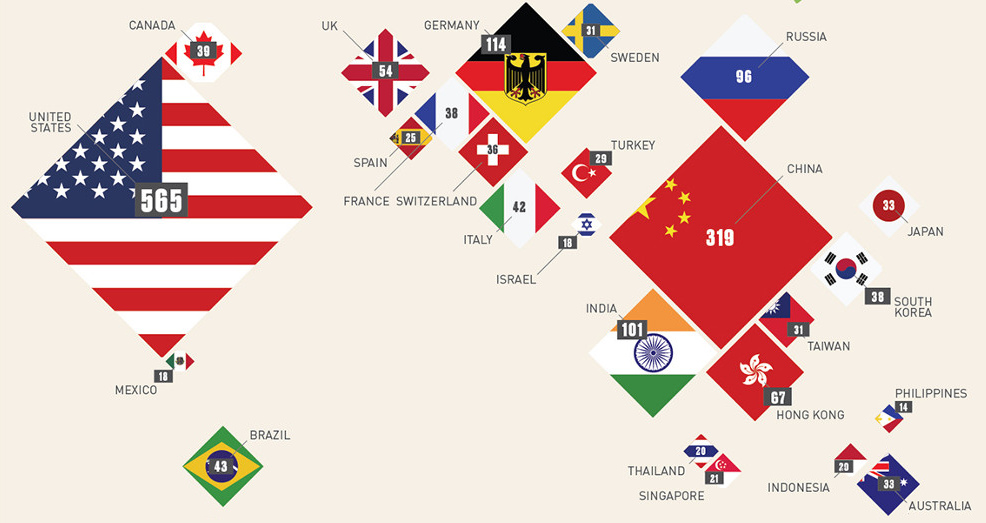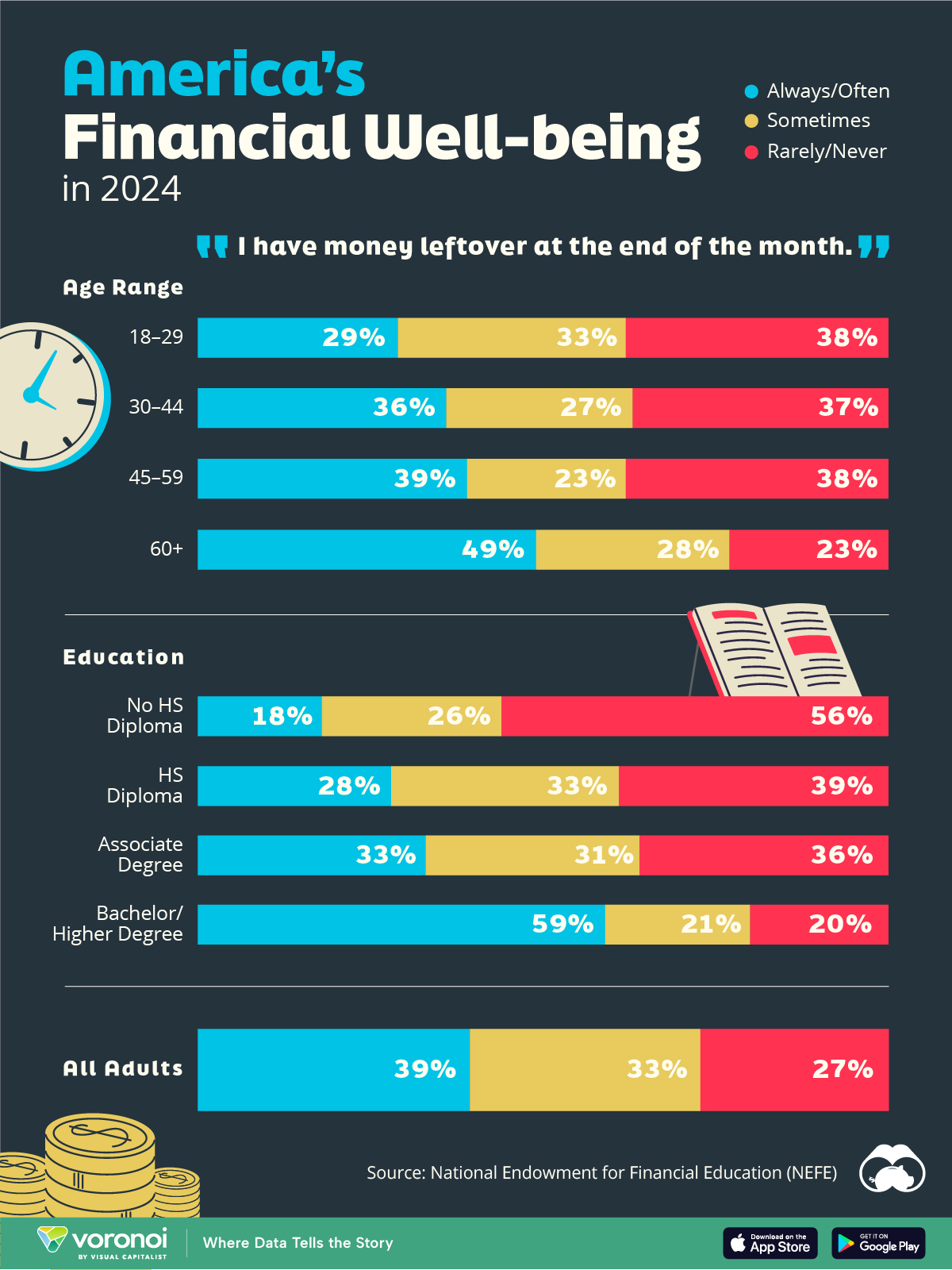Money
The 25 Countries With the Most Billionaires

The 25 Countries With the Most Billionaires
There are roughly 36 million millionaires in the world.
That means if you meet someone from the global population at random, there’s a 1 in 200 chance that they could be a millionaire – this makes for surprisingly good odds.
However, the billionaire on the other hand is a much rarer breed. According to Forbes, there are just over 2,000 billionaires in existence, making up just 0.00003% of the global population.
Where do these people live, and what countries have the highest concentrations of them as citizens?
25 Countries That are Rich in Billionaires
Today’s infographic comes to us from TitleMax, and it shows the 25 countries with the most billionaires in them. It also covers the richest person in each of these countries, as well.
Here is the list of countries, sorted by the number of billionaires:
| Rank | Country | Billionaires |
|---|---|---|
| #1 | United States | 565 |
| #2 | China | 319 |
| #3 | Germany | 114 |
| #4 | India | 101 |
| #5 | Russia | 96 |
| #6 | Hong Kong | 67 |
| #7 | United Kingdom | 54 |
| #8 | Brazil | 43 |
| #9 | Italy | 42 |
| #10 | Canada | 39 |
| #11 | South Korea | 38 |
| #12 | France | 38 |
| #13 | Switzerland | 36 |
| #14 | Australia | 33 |
| #15 | Japan | 33 |
| #16 | Sweden | 31 |
| #17 | Taiwan | 31 |
| #18 | Turkey | 29 |
| #19 | Spain | 25 |
| #20 | Singapore | 21 |
| #21 | Indonesia | 20 |
| #22 | Thailand | 20 |
| #23 | Israel | 18 |
| #24 | Mexico | 18 |
| #25 | Philippines | 14 |
The United States has the most billionaires in total with 565.
In second place is China (319) – a country that is adding billionaires at a rapid pace, but also losing some of its ultra-rich population to capital flight.
Billionaire concentration
Although the United States has the most billionaires by a large margin, the country ranks 6th in terms of billionaire concentration.
In the U.S., there is one billionaire for every 571,858 people, but it is beat out in this measurement by Hong Kong (110k), Switzerland (233k), Singapore (267k), Sweden (319k), and Israel (475k).
| Rank | Country | People per billionaire |
|---|---|---|
| #1 | Hong Kong | 109,657 |
| #2 | Switzerland | 232,556 |
| #3 | Singapore | 267,000 |
| #4 | Sweden | 319,452 |
| #5 | Israel | 474,833 |
| #6 | United States | 571,858 |
| #7 | Germany | 725,175 |
| #8 | Australia | 731,212 |
| #9 | Taiwan | 759,677 |
| #10 | Canada | 930,513 |
| #11 | United Kingdom | 1,215,566 |
| #12 | South Korea | 1,348,684 |
| #13 | Italy | 1,442,857 |
| #14 | Russia | 1,503,125 |
| #15 | France | 1,760,526 |
| #16 | Spain | 1,862,400 |
| #17 | Turkey | 2,741,724 |
| #18 | Thailand | 3,443,000 |
| #19 | Japan | 3,848,485 |
| #20 | China | 4,322,884 |
| #21 | Brazil | 4,830,233 |
| #22 | Philippines | 7,378,571 |
| #23 | Mexico | 8,500,000 |
| #24 | Indonesia | 13,055,000 |
| #25 | India | 13,108,911 |
Hong Kong, which has the highest rate of billionaires in the world, boasts 67 billionaires in just one city of roughly seven million.
For comparison’s sake, if Mainland China could somehow have the same rate of billionaire occurrences as Hong Kong, the country would amass 12,575 billionaires – more than six times the total amount in the world that currently exist!
Lowest Billionaire Concentrations
With only roughly 2,000 billionaires scattered throughout the world, it’s estimated that there are over 100+ countries and dependencies that actually have zero billionaires as citizens. For example, Haiti, Lithuania, Ethiopia, Belarus, and Andorra are just a few places that have millionaires, but no billionaires.
As for countries that made the above list, India and Indonesia are pretty scarce in terms of their billionaire concentrations – if you were to hit the street in these countries, the odds are 1 in 13 million that a random person would be a billionaire.
Money
Charted: Who Has Savings in This Economy?
Older, better-educated adults are winning the savings game, reveals a January survey by the National Opinion Research Center at the University of Chicago.

Who Has Savings in This Economy?
This was originally posted on our Voronoi app. Download the app for free on iOS or Android and discover incredible data-driven charts from a variety of trusted sources.
Two full years of inflation have taken their toll on American households. In 2023, the country’s collective credit card debt crossed $1 trillion for the first time. So who is managing to save money in the current economic environment?
We visualize the percentage of respondents to the statement “I have money leftover at the end of the month” categorized by age and education qualifications. Data is sourced from a National Endowment for Financial Education (NEFE) report, published last month.
The survey for NEFE was conducted from January 12-14, 2024, by the National Opinion Research Center at the University of Chicago. It involved 1,222 adults aged 18+ and aimed to be representative of the U.S. population.
Older Americans Save More Than Their Younger Counterparts
General trends from this dataset indicate that as respondents get older, a higher percentage of them are able to save.
| Age | Always/Often | Sometimes | Rarely/Never |
|---|---|---|---|
| 18–29 | 29% | 33% | 38% |
| 30–44 | 36% | 27% | 37% |
| 45–59 | 39% | 23% | 38% |
| Above 60 | 49% | 28% | 23% |
| All Adults | 39% | 33% | 27% |
Note: Percentages are rounded and may not sum to 100.
Perhaps not surprisingly, those aged 60+ are the age group with the highest percentage saying they have leftover money at the end of the month. This age group spent the most time making peak earnings in their careers, are more likely to have investments, and are more likely to have paid off major expenses like a mortgage or raising a family.
The Impact of Higher Education on Earnings and Savings
Based on this survey, higher education dramatically improves one’s ability to save. Shown in the table below, those with a bachelor’s degree or higher are three times more likely to have leftover money than those without a high school diploma.
| Education | Always/Often | Sometimes | Rarely/Never |
|---|---|---|---|
| No HS Diploma | 18% | 26% | 56% |
| HS Diploma | 28% | 33% | 39% |
| Associate Degree | 33% | 31% | 36% |
| Bachelor/Higher Degree | 59% | 21% | 20% |
| All Adults | 39% | 33% | 27% |
Note: Percentages are rounded and may not sum to 100.
As the Bureau of Labor Statistics notes, earnings improve with every level of education completed.
For example, those with a high school diploma made 25% more than those without in 2022. And as the qualifications increase, the effects keep stacking.
Meanwhile, a Federal Reserve study also found that those with more education tended to make financial decisions that contributed to building wealth, of which the first step is to save.
-

 Markets1 week ago
Markets1 week agoU.S. Debt Interest Payments Reach $1 Trillion
-

 Business2 weeks ago
Business2 weeks agoCharted: Big Four Market Share by S&P 500 Audits
-

 Real Estate2 weeks ago
Real Estate2 weeks agoRanked: The Most Valuable Housing Markets in America
-

 Money2 weeks ago
Money2 weeks agoWhich States Have the Highest Minimum Wage in America?
-

 AI2 weeks ago
AI2 weeks agoRanked: Semiconductor Companies by Industry Revenue Share
-

 Markets2 weeks ago
Markets2 weeks agoRanked: The World’s Top Flight Routes, by Revenue
-

 Demographics2 weeks ago
Demographics2 weeks agoPopulation Projections: The World’s 6 Largest Countries in 2075
-

 Markets2 weeks ago
Markets2 weeks agoThe Top 10 States by Real GDP Growth in 2023















